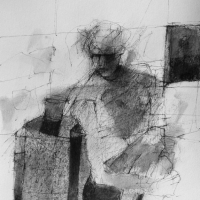


Although an abridged edition (the original was published in 1791), I took away a good appreciation of the personality and brilliance of this great lexicographer, as well as his 18th century England and friends. I also read Life of Samuel Johnson by James Boswell.

I have not yet seen the movie but the essay is gripping in its descriptions. The Lady in the Van describes the life of a bag lady whom Bennett befriended in London and who takes up residence in his backyard. (One of the stories serves as the foundation for the eponymous current movie.) I came to the book because I enjoyed two other books by Bennett: Uncommon Reader (a fictional, unlikely, and whimsical account of Queen Elizabeth II in which the queen suddenly becomes interested in reading great literature) and Smut, a collection of essays. In the second category, I read a collection of essays by Alan Bennett entitled The Lady in the Van and Other Stories. Having red hair herself, Colliss describes the anguish, social prejudices, and challenges redheads have faced throughout history up to the present.

Like Herzig, Colliss discusses the meaning of hair but she does it from the perspective of the redhead. I also read and liked Jacky Colliss Harvey’s Red: A History of the Redhead. Herzig asks evolutionary questions about why humans lost their body hair compared to other apes and what it is about hair which drives humans to remove it. It’s a detailed, well-documented, scholarly description of the human preoccupation with body hair, from the fastidious attention ancient Egyptians gave to facial hair to the modern obsession with pubic hair. Readings that give me some insight into creative and disciplined writing.ĭuring the last two months, readings in the first category (and relevant to my new book, Hair: A Human History) included Rebecca Herzig’s Plucked: A History of Hair Removal, which was published by New York University Press last year. General science and readings related to my current project, and 2. His reply: My book reading falls into two categories: 1. Recently I asked the author about what he was reading. Stenn's new book is Hair: A Human History. He has lectured extensively on the biology of the hair follicle, written over 200 peer review scientific publications and served on the Adjunct Faculties of the University of Pennsylvania Medical School, Drexel University, and Georgia Institute of Technology. Most recently, he helped found and served as Chief Scientific Officer for a biotech startup focusing on hair follicle regeneration. He had a distinguished twenty-year academic career as a Professor of Pathology and Dermatology at the Yale University School of Medicine and was for ten years Director of Skin Biology at Johnson & Johnson. Kurt Stenn has over 30 years of expertise studying hair.


 0 kommentar(er)
0 kommentar(er)
